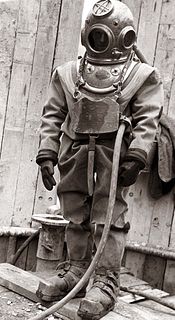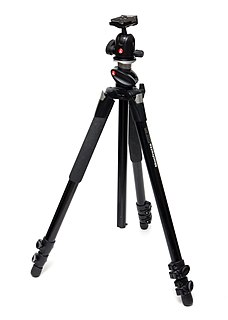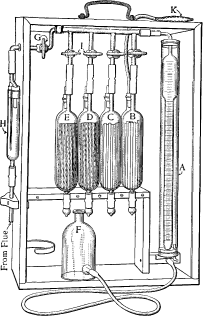A burette is a graduated glass tube with a tap at one end, for delivering known volumes of a liquid, especially in titrations. It is a long, graduated glass tube, with a stopcock at its lower end and a tapered capillary tube at the stopcock's outlet. The flow of liquid from the tube to the burette tip is controlled by the stopcock valve. There are two main types of burette; the volumetric burette and the Piston burette or Digital burette.

A dry suit or drysuit provides the wearer with environmental protection by way of thermal insulation and exclusion of water, and is worn by divers, boaters, water sports enthusiasts, and others who work or play in or near cold or contaminated water. A dry suit normally protects the whole body except the head, hands, and possibly the feet. In hazmat configurations, however, all of these are covered as well.

Injection moulding is a manufacturing process for producing parts by injecting molten material into a mould, or mold. Injection moulding can be performed with a host of materials mainly including metals, glasses, elastomers, confections, and most commonly thermoplastic and thermosetting polymers. Material for the part is fed into a heated barrel, mixed, and injected into a mould cavity, where it cools and hardens to the configuration of the cavity. After a product is designed, usually by an industrial designer or an engineer, moulds are made by a mould-maker from metal, usually either steel or aluminium, and precision-machined to form the features of the desired part. Injection moulding is widely used for manufacturing a variety of parts, from the smallest components to entire body panels of cars. Advances in 3D printing technology, using photopolymers that do not melt during the injection moulding of some lower temperature thermoplastics, can be used for some simple injection moulds.

In the United States, Canada and the United Kingdom, grips are technicians in the filmmaking and video production industries. They constitute their own department on a film set and are directed by a key grip. Grips have two main functions. The first is to work closely with the camera department to provide camera support, especially if the camera is mounted to a dolly, crane, or in an unusual position, such as the top of a ladder. Some grips may specialize in operating camera dollies or camera cranes. The second main function of grips is to work closely with the electrical department to create lighting set-ups necessary for a shot under the direction of the director of photography.
Grips' responsibility is to build and maintain all the equipment that supports cameras. This equipment, which includes tripods, dollies, tracks, jibs, cranes, and static rigs, is constructed of delicate yet heavy duty parts requiring a high level of experience to operate and move. Every scene in a feature film is shot using one or more cameras, each mounted on highly complex, extremely expensive, heavy duty equipment. Grips assemble this equipment according to meticulous specifications and push, pull, mount or hang it from a variety of settings. The equipment can be as basic as a tripod standing on a studio floor, to hazardous operations such as mounting a camera on a 100 ft crane, or hanging it from a helicopter swooping above a mountain range.
Good Grips perform a crucial role in ensuring that the artifice of film is maintained, and that camera moves are as seamless as possible. Grips are usually requested by the DoP or the camera operator. Although the work is physically demanding and the hours are long, the work can be very rewarding. Many Grips work on both commercials and features.

Standard diving dress is a type of diving suit that was formerly used for all relatively deep underwater work that required more than breath-hold duration, which included marine salvage, civil engineering, pearl shell diving and other commercial diving work, and similar naval diving applications. Standard diving dress has largely been superseded by lighter and more comfortable equipment.

Surface-supplied diving is diving using equipment supplied with breathing gas using a diver's umbilical from the surface, either from the shore or from a diving support vessel, sometimes indirectly via a diving bell. This is different from scuba diving, where the diver's breathing equipment is completely self-contained and there is no link to the surface. The primary advantages of conventional surface supplied diving are lower risk of drowning and considerably larger breathing gas supply than scuba, allowing longer working periods and safer decompression. Disadvantages are the absolute limitation on diver mobility imposed by the length of the umbilical, encumbrance by the umbilical, and high logistical and equipment costs compared with scuba. The disadvantages restrict use of this mode of diving to applications where the diver operates within a small area, which is common in commercial diving work.

A collet is a subtype of chuck that forms a collar around an object to be held and exerts a strong clamping force on the object when it is tightened, usually by means of a tapered outer collar. It may be used to hold a workpiece or a tool.
Various bicycle tools have evolved over the years into specialized tools for working on a bicycle. Modern bicycle shops will stock a large number of tools for working on different bicycle parts. This work can be performed by a trained bicycle mechanic, or for simple tasks, by the bicycle owner.

A nipple clamp is a sex toy. It is a clamp that is applied to the nipples of a person of either gender. It causes pain by the pinching of the nipple, by the restriction of blood flow, and by the reintroduction of blood flow. Nipple clamps are used in some BDSM activities, such as breast torture. The main types of nipple clamps are the clothes-pin-style clamp, tweezer clamp, clover clamp, and piercing clamp, though any device that applies direct pressure can be used.

In photography, a tripod is used to stabilize and elevate a camera, a flash unit, or other photographic equipment. All photographic tripods have three legs and a mounting head to couple with a camera. The mounting head usually includes a thumbscrew that mates to a female threaded receptacle on the camera, as well as a mechanism to be able to rotate and tilt the camera when it is mounted on the tripod. Tripod legs are usually made to telescope, in order to save space when not in use. Tripods are usually made from aluminum, carbon fiber, steel, wood or plastic.

A vise or vice is a mechanical apparatus used to secure an object to allow work to be performed on it. Vises have two parallel jaws, one fixed and the other movable, threaded in and out by a screw and lever.

In electrical and electronic engineering, a current clamp, also known as current probe, is an electrical device with jaws which open to allow clamping around an electrical conductor. This allows measurement of the current in a conductor without the need to make physical contact with it, or to disconnect it for insertion through the probe.

A fitting or adapter is used in pipe systems to connect straight sections of pipe or tube, adapt to different sizes or shapes, and for other purposes such as regulating fluid flow. These fittings are used in plumbing to manipulate the conveyance of water, gas, or liquid waste in domestic or commercial environments, within a system of pipes or tubes.

Ground glass joints are used in laboratories to quickly and easily fit leak-tight apparatus together from commonly available parts. For example, a round bottom flask, Liebig condenser, and oil bubbler with ground glass joints may be rapidly fitted together to reflux a reaction mixture. This is a large improvement compared with older methods of custom-made glassware, which was time-consuming and expensive, or the use of less chemical resistant and heat resistant corks or rubber bungs and glass tubes as joints, which took time to prepare as well.

A workbench is a table used by woodworkers to hold workpieces while they are worked by other tools. There are many styles of woodworking benches, each reflecting the type of work to be done or the craftsman's way of working. Most benches have two features in common: they are heavy and rigid enough to keep still while the wood is being worked, and there is some method for holding the work in place at a comfortable position and height so that the worker is free to use both hands on the tools. The main thing that distinguishes benches is the way in which the work is held in place. Most benches have more than one way to do this, depending on the operation being performed.

Locking pliers are pliers that can be locked into position, using an over-center toggle action.

In chemistry, a retort stand, also called a clamp stand, a ring stand, or a support stand, is a piece of scientific equipment intended to support other pieces of equipment and glassware — for instance, burettes, test tubes and flasks..

An Orsat gas analyser is a piece of laboratory equipment used to analyse a gas sample for its oxygen, carbon monoxide and carbon dioxide content. Although largely replaced by instrumental techniques, the Orsat remains a reliable method of measurement and is relatively simple to use.

A tripod head is the part of a tripod system that attaches the supported device to the tripod legs, and allows the orientation of the device to be manipulated or locked down. Modular or stand-alone tripod heads can be used on a wide range of tripods, allowing the user to choose which type of head best suits their needs. Integrated heads are built directly onto the tripod legs, reducing the cost of the tripod system.

A clamp holder or clamp fastener is a piece of laboratory apparatus that is used to secure laboratory clamps, such as extension-type utility clamps, or other attachments to a ring stand or lab frame. The material can be made up of brass, cast iron, stainless steel, aluminium or nickel-plated zinc.






















